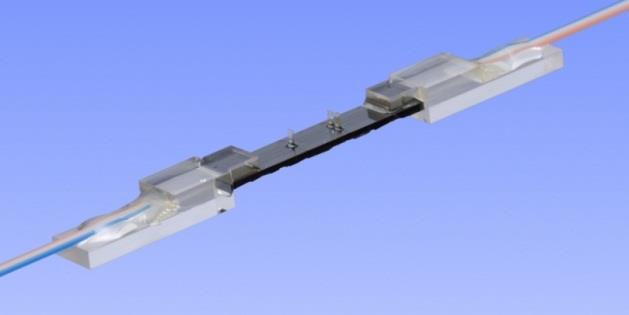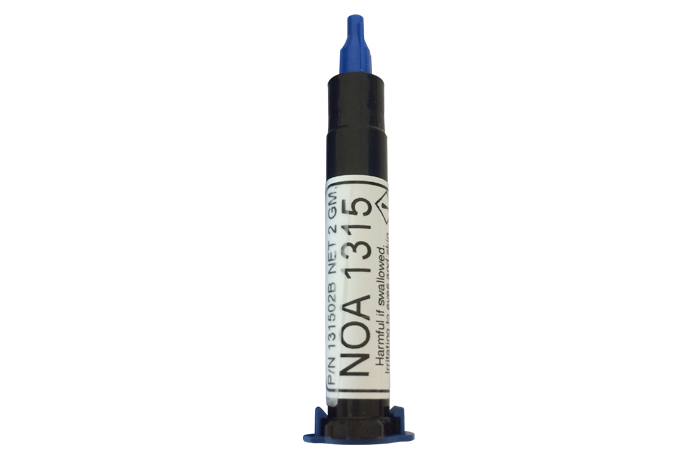Standard Types Fiber Bragg Gratings
Wavelength 600-2300 nm; Bandwidth 0.05-50 nm; Reflectivity 0.2-99.9%; SLSR ~8->15 dB; Fiber Type SM, PM, Double Clad, LMA, Custom; Fiber Pigtail Length ≥0.5, CustomFiber Bragg gratings (FBGs) have many applications in optical communication, laser technique and sensing systems. Greitlex Photonics’ series of standard types FBGs are widely used for applications like in-fiber mirrors or optical filters with narrowband optical spectrum and can act as a sensor element for strain and temperature measuring.Within Greitlex Photonics’ series of standard types fiber Bragg gratings (FBG) you find:Uniform Fiber Bragg GratingsApodized Fiber Bragg GratingsChirped Fiber Bragg GratingsApodized-chirped Fiber Bragg GratingsFiber Laser Matched Fiber Bragg GratingsTilted Fiber Bragg Gratingsπ-Phase-Shifted Fiber Bragg GratingsGTL-FBG-UF-810 uniform fiber Bragg gratings are produced with grating lengths from 0.5 mm to 10 mm. Such gratings show their full width at half maximum (FWHM) from 0.015 nm (R = 25%) to 0.03 nm (R = 90%) for 633 nm wavelength (0.1 nm and 0.17 nm at 1580 nm) and gratings length 9 mm. Standard uniform FBGs have a bandwidth of 0.15 nm to 0.6 nm, a reflectivity of 5% to 99% and grating lengths of 1 mm to 3.5 mm.Fiber Bragg gratings are sensitive to changes of strain and temperature. Uniform FBGs can be provided as separated units or chains of FBGs with different wavelengths. By using chain FBGs, multipoint monitoring of temperature, strain or other physical parameters is available. Different types of single mode optical fibers and fiber coatings are used. Acrylate coated fibers for normal temperature range of -40˚C to +100˚C. Polyimide or metal (Cu, Al) coated fibers are used for high-temperature applications with maximum temperatures of +300˚C and +500˚C respectively.GTL-FBG-AD-820 apodized fiber Bragg gratings show a special profile of induced refractive index and grating strength along the grating length. Therefore, the side lobes level becomes smaller compared to ordinary gratings. There are a lot of apodized profiles which lead to the optimization of various FBG parameters (strength, FWHM, side lobe suppression ratio (SLSR)). Apodized FBGs are useful in sensing applications, signal and Brillouin scatter filtering and others. Possible value of SLSR for different grating strengths is -10 dB to -30 dB.Our GTL-FBG-CR-840 chirped fiber Bragg gratings feature a linear variation of the FBG period along the grating length. Chirped FBGs are manufactured by using a non-periodic phase mask. The available chirp rate of the phase mask period can range from 0.01 nm/cm to 30 nm/cm. Therefore, such FBGs have a wide spectrum bandwidth and special dispersion characteristics. Chirped FBGs are useful for gain-flattening EDFA and ASE light sources, band stop filters, in ultrafast mode-locked fiber lasers, powerful lasers, and chromatic dispersion compensation telecom systems.Apodization of chirped FBG is necessary to obtain FBGs with a smooth reflection spectrum. There are several apodization profiles that lead to the optimization of various parameters of the FBG such as reflection coefficient, FWDM, side lobe suppression ratio (SLSR), or the parameter of dispersion. In chirped FBGs the dispersion is determined by the rate of change of the period along the length of the FBG. Within the GTL-FBG-ADG-820 series of apodized-chirped fiber Bragg gratings, FORC Photonics has implemented several types of apodization profiles: Sine, Gauss, Semi Gauss and Super Gauss.The simplest type of apodization is "Sine", which "saves" the length of the FBG and provides a (SLSR) value of about 20 dB. The "Gauss" apodization function provides the best SLSR value in the order of 30 dB. For many applications, such as pulsed fiber lasers, there are special requirements for the dispersion value and the shape of the reflection profile. "Gauss" apodization of chirped FBGs allows to obtain excellent results in these applications. The "SuperGauss" type of apodization is intended for obtaining a flat-top reflection spectrum. Apodized FBGs are useful in sensing applications, signal and Brillouin scatter filtering and others.Our GTL-FBG-LP-830 fiber laser matched FBG pairs are an ideal solution for fiber laser fabrication. Minimum insertion losses and other parameters are optimal for lasers with output powers of several tens of W. High- and low-reflection gratings are available, with the high-reflection grating showing -20 dB levels of about 0.5 nm to 0.7 nm. The low-reflection output grating with 5% to 40% reflectivity has FWHM values of 0.15 nm to 0.35nm. The mismatching of LR relative to HR grating is up to ±0.15 nm. For narrow-line fiber lasers we provide FBG pairs with FWHM values around or below 0.1 nm for ideal matching without adjustment.GTL-FBG-TL-860 tilted fiber Bragg gratings have an angle between the wave vector of the grating and the fiber axis. Therefore, cladding modes resonance peaks become more intensive compared to ordinary gratings. The wavelengths of tilted fiber Bragg gratings cladding modes resonances are highly sensitive to the refractive index of the medium outside the fiber cladding. TFBGs are useful in sensing applications. Possible values of the tilt angle are 1⁰ to 45⁰.GTL-FBG-PS-870 π-phase-shifted fiber Bragg gratings have a very narrow peak within their transmission/reflection spectrum. Phase-shifted FBGs are gratings with a phase defect in the center. While the grating length determines its bandwidth, the spectral width of that peak depends on the strength of the FBG’s both parts. Typical FWHM values for our π-phase-shifted fiber Bragg gratings are 0.1 nm to 0.005 nm. A typical application of phase-shifted FBGs are narrow-bandwidth optical filters for single-frequency fiber lasers.All these FBGs replace similar products from former FORC Photonics. Key Features:The following configurations can be changed at the customer's request, please contact AMS Technologies to discuss a customized fiber Bragg grating solution tailored to your project’s requirements.
GTL-FBG-UF-810 Uniform FBGs
GTL-FBG-AD-820 Apodized FBGs
GTL-FBG-CR-840 Chirped FBGs
GTL-FBG-ADG-820 Apodized-chirped FBGs
GTL-FBG-LP-830 Fiber Laser Matched FBG Pairs
GTL-FBG-TL-860 Tilted FBGs
GTL-FBG-PS-870 π-phase-shifted FBGs
Wavelength Range [nm]
600 - 2300
Wavelengths to Quick Order [nm]
-
-
1069, 1081, 1529, 1875
30 values between 633 and 2300
Fiber Type
Single Mode (SM), Polarization Maintaining (PM), Double Clad, LMA, Custom
SM, PM, Double Clad, Custom
Single Mode (SM), Polarization Maintaining (PM), Double Clad, LMA, Custom
Reflectivity [%]
0.2 - 99.9
0.5 - 99.9
5 - 99
5 - >99
5 - 99
Tilt Angle
-
-
-
-
-
1° - 45°
-
Chirp Rate [nm/cm]
-
-
0.01 - 30
0.01 - 25
-
-
-
Bandwidth (WFHM) [nm]
0.05 - 1.2
0.1 - 1.2
2 - 50
0.5 - 50
0.1 - 1.2
0.1 - 0.8
Grating (FBG) Length [mm]
-
-
2 - 50
-
-
-
-
SLSR [dB]
~8
>10, >15
~8
>15
-
~8
FBG Pigtail Length [m]
≥0.5, Custom
-
≥0.5, Custom
FBG Recoating
None, Acrylate, Polyimide, Aluminium, Copper, Custom
None, Acrylate, Polyimide, Custom
None, Low- or High-index Polymer, Acrylate, Polyimide, Custom
None, Acrylate, Polyimide, Aluminium, Copper, Custom
Tensile Strength [kpsi]
>100
-
>100
Optical Connector
Bare Fiber, FC/APC, LC/APC, Custom
-
Bare Fiber, Custom
Bare Fiber, FC/APC, LC/APC, Custom
Package Dimensions LxWxH [mm]
-
-
-
-
25 x 10 x 6.0
-
-
Applications: In-fiber Mirrors; Narrowband Optical Filters; (Multipoint) Strain & Temperature Sensing; Signal and Brillouin Scatter Filtering; Gain-flattening EDFAs; ASE Light Sources; Band Stop Filters; Pulsed, Ultrafast Mode-locked & Single-frequency Fiber Lasers; Powerful Lasers; Chromatic Dispersion Compensation Telecom Systems; Other
Product number:
SW11871
Manufacturer:






